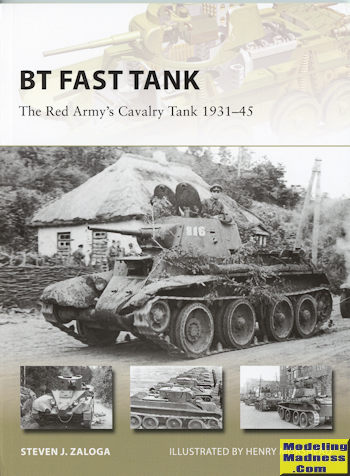 In
the years following WWI, the weapons designers of various nations were working
with a fairly clean slate when it came to major military equipment. While the
aircraft had its design pretty well stabilized, the same could not be said of
the tank.
In
the years following WWI, the weapons designers of various nations were working
with a fairly clean slate when it came to major military equipment. While the
aircraft had its design pretty well stabilized, the same could not be said of
the tank.
The most successful tanks of the war were those used by the British, but
those were obvious dead ends as much due to their size as well as their
design. Where the future of the tank was shown was by the French with their
small FT 17. While not at all a large tank, it had all of the main design
features that are still in use with tanks today. Based on this, there were a
large variety of designs, one of the most interesting by Christie.
The Christie tank was a fairly fast tank as the type goes. It was able
to remove the tracks and run on its large, rubber rimmed road wheels at a speed
that a tracked vehicle was unable to match. This allowed the tank to move fairly
long distances to near the front lines where the tracks would be replaced and
the tank operated as usual.
Many nations liked the Christie design and used it with their tanks. One
of them was the Soviet Union. The US government was not keen on selling
equipment to communists, but things can always be worked around and so it was
with the Christie tank. Christie's quality control was pretty poor and tanks
built by the company tended to be poorly built. The Soviets took the Christie
design, adapted it, and the BT tank design was born.
Initial tanks were powered by surplus Liberty aircraft engines, but were
later powered by copied WWI BMW aero engines, and even later a few diesels. The
first tanks had 37mm cannon based on US designs, but later the more potent 45mm
version. Typical of tanks of the time, the armor was quite thin and while some
tanks later had appliqué armor which helped somewhat, the BT series were, like
the T-26, easily destroyed by the time's anti-tank guns.
Not surprisingly, the vast majority of available BT tanks were lost
during the first six months of the German invasion of 1941. They also suffered
against the Finns, though were about the equals of the Japanese tanks met in the
late 1930s. About the only place where they were king was during the Spanish
Civil War, though they were poorly used by inept commanders, a problem that
plagued the Soviets for most of wars of the early 1940s.
In this book the author covers the interesting development of this tank
as well as all the issues the Soviets had with equipment and their lack of
satisfaction on its early reliability. All the various subtypes from the BT-2 to
BT-8 are covered with more emphasis put on those which entered large scale
production. There are tons of great photos and the art work of Henry Morshead
really adds a lot to the reading experience.
I found it to be a most interesting read and learned quite a bit about
this interesting vehicle. I can assure you that you will like it as well.
September 2016
Copyright ModelingMadness.com
For more on the complete line of Osprey books, visit
http://www.ospreypublishing.com
If you would like your product reviewed fairly and
fairly quickly, please
contact
the editor or see other details in the
Note to
Contributors.
 In
the years following WWI, the weapons designers of various nations were working
with a fairly clean slate when it came to major military equipment. While the
aircraft had its design pretty well stabilized, the same could not be said of
the tank.
In
the years following WWI, the weapons designers of various nations were working
with a fairly clean slate when it came to major military equipment. While the
aircraft had its design pretty well stabilized, the same could not be said of
the tank.